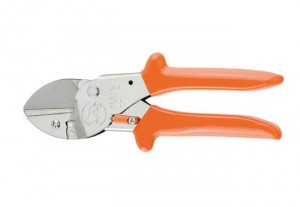| File | Title | File Description | Type | Section |
|---|---|---|---|---|
| Original-LOWE_GardenPRO2024-EN-compressed.pdf | Lowe Pruning Catalogue and Spare Parts Diagrams | Catalogue | Document |

Bypass or Parrot-beak secateurs: as the name suggests the blade bypasses the counter blade to make a cut. (i.e. the action is similar to scissors). ?One blade is convex and the other concave. The main reason you would use the bypass to cut smaller branches and dense foliage as the blades are thinner and allow easier manoeuvrability e.g. with vines or roses.

Anvil secateurs: Have an upper blade which pushes down to an anvil counter blade (i.e. they close to a flat surface). The blade is bigger than the Bypass and the action tends to slice rather than squash the branch. Anvil secateurs will give a clean cut. Anvil is used for softer wooded trees and plants like Cherries, Pear and Olives.

Double-Blade secateurs: Have two identical blades if you compare to the anvil or bypass type? These secateurs make a cut by slicing the branch from two sides of the stem. Since you are cutting equally from both sides you tend to finish the cut in the middle of the stem where a lip is present. The reason for the lip at the end of the stem is to create angles each side and ensure that no water can settle on the cut to help the wound heal without the added risk of infection.
When you use secateurs on a regular basis you need to take into account the clunk/jarring factor to reduce the impact for RSI (Repetitive Strain Injury) purposes of each of these models:
The clunk or jar factor is what you feel at the end of a cut. A bypass secateurs gives the biggest clunk and you find these types of secateurs are not the choice of Arborists. Whereas Double-blade type secateurs have some jarring and the Anvil has no jarring at all and is usually the choice for Arborists.
What else to look for when choosing the right secateurs?
Everyone has a different sized-hands and secateurs are made in a facade of different sizes and shapes. Feel the secateurs in your hands open and close them like you are making a cut and feel if your hand can extend the reach of the handles when open. ?Rolling handles may be an option or not. The rolling handle model are usually more expensive and may not be better for the fit of your hand.
Everyone has a different sized-hands and secateurs are made in a facade of different sizes and shapes. ?Feel the secateurs in your hands open and close them like you are making a cut and feel if your hand can extend the reach of the handles when open. ?Rolling handles may be an option or not. The rolling handle model are usually more expensive and may not be better for the fit of your hand.
Here are some other facts about secateurs:
The next time you look for secateurs, take into consideration the application and frequency of use. ?Choose what is comfortable and practical for your application!
More about: